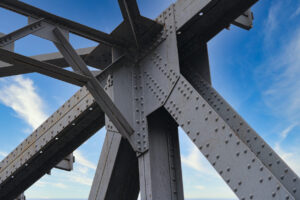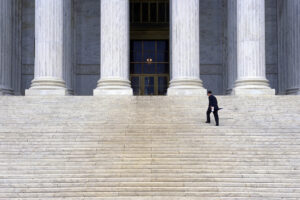The famous hoary aphorism holds that the law is a seamless web. Seamless it may be, but with each passing day the web weavers expand its size and use it to cover spaces that in earlier times did not even exist. And as these new fields of endeavor grow, disputes about them inevitably find their way to the country’s courts.
Like others, litigators cannot fail to have noticed the rapid advance of technology into all corners of modern life. This advance has radically transformed the practice of law and the businesses of clients. Ongoing innovations in law practice, client relationships, and relationships with the bench have added to the ferment. So it is no surprise that any treatise that describes business litigation would need to be updated on a regular basis. That is the case with Business and Commercial Litigation in Federal Courts (Robert L. Haig, ed.), a multivolume work published by the ABA’s Litigation Section. Previous editions were published in 1998, 2005, 2011, and 2016. The fifth edition was published in December 2021.
The fifth edition in its hardcopy form stretches over sixteen volumes. It includes 180 chapters, of which twenty-six are on entirely new topics. Hundreds of attorneys and judges contributed to the fifth edition as authors, including some of the most prominent names in their fields.
The treatise is not limited to describing legal and strategic issues or recent developments in specified areas of business law. Each chapter also ends with a checklist and, where appropriate, customizable forms. Depending on the topic, the checklists vary from lists of tasks to accomplish to lists of issues an attorney should consider. The overall result is a work that provides an effective overview of business litigation in numerous substantive areas, as well as detailed coverage of procedural topics, together with practical pointers and reminders.
Comparisons with other court systems
Although the title of the treatise posits a focus on federal litigation, the fifth edition has added several chapters comparing business litigation in US federal courts with business litigation in US state courts generally, and with New York and Delaware courts in particular—New York and Delaware being the states whose courts most commonly encounter business litigation, both domestic and cross-border. The new edition also adds chapters comparing business litigation in US federal courts with similar litigation in Canada and Mexico. With these additions the treatise can serve as a valuable jumping-off point for litigators who find themselves in need of guidance either when deciding which court system they prefer or in counseling clients at the outset of litigation about what issues they need to be concerned about. These new chapters are not, and cannot be, comprehensive analyses of procedure in these jurisdictions—each one has treatises of its own dedicated to just that—but they do provide a useful starting point.
The chapter on state courts generally is necessarily a broad overview; after all, a deep dive into fifty different court systems would likely have been impractical. But as a place to begin, it provides useful analysis of how to think about the differences between federal and state court litigation, as well as issues to consider in the decision about which state court to sue in. For example, litigators selecting a forum should look at such matters as quality of procedures, perceived quality of judges, whether the state system has a specialized business court, how the state handles discovery issues, what the privilege rules are, how difficult it is to get interim relief, and how long the trial backlog is. The checklist at the end of the chapter sets forth the issues litigators should consider in forum selection.
New York and Delaware are two of the premier American locations for business litigation. Let’s look at the chapter on New York as an example of how the new edition approaches the comparison between federal and other courts. The chapter begins with strategic considerations in choosing between federal and New York courts. One feature that is unique to New York is the availability of interlocutory appeals. Almost alone among states, New York practice permits most orders to be appealed, rather than requiring the parties to wait until the end of the case. This can affect cost, settlement prospects, and many of the decisions counsel must make during the course of the case.
Actual litigation procedures are more alike than different, though there are variations in timing and nuance. For example, summary judgment motions in New York may be made only after an answer is filed. A jury may be requested until discovery closes, with the filing of a “note of issue.” Unlike in federal court, a plaintiff in New York state court who advances both legal and equitable claims in the same case is deemed to have waived a jury on the legal claims.
Even where the normal New York rules differ noticeably from the federal rules, the Commercial Division of the New York Supreme Court has adopted many rules that adjust normal New York state procedures to bring them more into line with the federal rules, particularly with respect to discovery and some aspects of motion practice. So the differences tend to be more in the details than in the broad strokes. But some differences do remain.
The chapters comparing business litigation in Delaware, Canada, and Mexico with federal litigation likewise provide useful guideposts to the most salient differences. These chapters are accompanied by useful checklists of issues and strategic decision points.
Given the constraints of the space and the breadth of the subject matter, these chapters are a valuable addition to the treatise that will serve users in good stead—not as exhaustive surveys but as useful bird’s-eye views of the various considerations to take into account. One may perhaps quibble with the omission of a chapter comparing US federal courts with the proverbial 800-pound gorilla, California, which has its own unique procedures and a much more statute-oriented legal system than many other states. California generates an enormous volume of litigation, and its courts’ decisions are influential in a number of other states. Perhaps it will be included in the next edition.
New Chapters on Law Practice
Other new chapters look at emerging issues in law practice. Among these are “Budgeting and Controlling Costs,” “Coordinating Counsel,” “Fee Arrangements,” “Third-Party Litigation Funding,” and “Use of Jury Consultants.”
Let’s take as an example a subject most practicing attorneys care about deeply (for obvious reasons): fee arrangements. Litigators no doubt are familiar with various alternative fee arrangements and have taken note of increased use of billing methods other than straight hourly billing, such as contingencies or flat fees. But how to choose which arrangement works best? What incentive structures does each create for the attorney and the client? How can the downsides of each structure be minimized? Are there feasible ways to combine features of various structures into a mutually acceptable arrangement? What ethical issues can come into play in each structure?
The new chapter tackles these issues in systematic fashion. It gives pointers regarding how to think about what kind of fee arrangement to use. For example: as a practical matter, what kind of fee arrangement is feasible in any particular case? How do the incentives line up for the client and for the lawyer? What sort of arrangement is most likely to permit the client to achieve its goals?
The chapter describes each of the usual kinds of fee arrangements, together with hypothetical examples of how they work. The risks of a mistaken expectation should be considered when structuring the fee arrangement. Some ways of dealing with this risk include combinations or variations of different kinds of structures, such as by caps, escalators, partial contingencies, guaranteed minimums, collars, or using a monthly floor or ceiling to control expectations.
The checklist at the end of the chapter goes step by step through the analysis that is needed at each stage of the process for either hourly or flat fee arrangements or for conventional contingent fee setups. It does not include checklists for other possible structures, but one may infer that is because the universe of possibilities is so large that no checklist can account for every conceivable variation. The forms supply model paragraphs for inclusion in an engagement letter in a number of different types of fee agreements.
Another new chapter discusses third-party litigation funding. This subject has been in the news lately, with some high-profile cases going ahead with the backing of litigation funders. But many practitioners are unfamiliar with the nuts and bolts of how litigation funding works and don’t have a good idea of what the pitfalls might be. The new chapter lays out the basics: when is funding feasible or sensible? How is it set up? How does an attorney or client locate and vet a funder? What terms are typical? What does a funder expect from an attorney or from the client? What kind of vetting should the attorney and client expect from the funder? How does the process work once a funder is in place, in terms of periodic reports and control of litigation? How much input does the funder have on settlement decisions?
Perhaps most interesting are the sections on ethical issues. The presence of a funder can affect the scope of work product and privilege, and care must be taken to avoid waivers. Here the chapter provides some specific recommendations. Another ethical consideration is how to structure the funding agreement to ensure it does not run afoul of the fee-splitting rules. Interestingly, some of the recent case law highlights the need to avoid running afoul of champerty statutes; these statutes may be antiquated, but certain states still enforce them and will refuse to uphold funding arrangements that run afoul of them.
It remains to be seen how much development there will be in this area, whether on the business side or the case law side. But for now, this chapter is an effective overview of the issues that an attorney can comfortably consult at the beginning of his or her analysis of the subject.
Other chapters likewise build on new developments in both law and technology. For example, the chapter “Budgeting and Controlling Costs” contains extensive discussion of electronically stored information (ESI) discovery and the rules governing it, as well as discussion of using technology at trial. But it also covers ways to think about, plan for, and budget for other time-tested features of American litigation such as pleadings, motions, conferences, and appeals.
New Areas of Substantive Law
Several of the new chapters address areas of substantive law that either did not exist in developed form at the time of the fourth edition or, for whatever reason, were not included in earlier editions. Some of the new substantive law chapters include “Art Law,” “Fraudulent Transfer,” “Monitorships,” “Political Law,” “Shareholder Activism,” “Trade Associations,” and Virtual Currencies.
One obvious new area of law is artificial intelligence. It is likely that the chapter is already in need of updating, what with the advent just this year of ChatGPT, BingAI, Bard, and other new AI interfaces. The availability of these tools has raised a host of new issues that are being discussed in the legal press and in the profession generally. The issues include serious questions about how professional responsibility meshes with the use of AI as a tool for lawyers.
Although the chapter obviously does not address new questions that arose after publication, the chapter is illuminating for its focus on the basics of what AI is, how it works, what assumptions may be built into the algorithms, and how it can be used in law practice consistent with applicable ethical rules. It starts with the basics: what is AI and how does it work? Conceptually, it is not hard to demystify: AI is simply software that uses algorithms to find patterns in large volumes of data and incorporates what it “learns” into its continuing operation. But each of those steps contains pitfalls: are there biases in the algorithm? Is the algorithm selecting appropriate features from the data? Is it weighting the inputs properly? For this reason, use of AI in business decisions may lead to tussles over discovering the algorithm if the decisions lead to litigation. The degree to which it is discoverable is not yet established—case law is still developing. And attorneys’ need to analyze algorithms will undoubtedly lead to an increase in demand for both consulting and testifying experts.
AI has already made its way into discovery. The most familiar manifestation is predictive coding, which is actually just an application of AI to identify patterns in the contents of documents that indicate whether documents are responsive to document requests or otherwise relevant. The availability of this AI tool may affect a litigant’s ability to argue a request is burdensome if that litigant declines to use predictive coding or other technology-assisted search techniques. AI may also provide new ways for assessing probabilities of outcomes at various steps in a litigation as well as the ultimate outcome of a case.
All this raises issues of professional responsibility, which the chapter addresses forthrightly. Consider: does the availability of AI imply that lawyers must become familiar with it as part of the normal standard of care? Must the attorney consult with the client about whether and to what extent to use AI? Is the AI constructed in a manner that will adequately preserve confidentiality, and are technology vendors blocked from seeing the contents of what is provided to them? Can “outsourcing” some work to AI skate close to facilitating the unauthorized practice of law?
The chapter concludes with a checklist that addresses the issues a practitioner should account for in a protective order when a case involves use of AI, and a sample request for production of AI-related documents pertaining to such items as the underlying algorithm, weighting, or validity studies. Of course this area is developing so quickly that new issues arise seemingly by the week. Undoubtedly pocket part/updates will be on the way.
Another new chapter addresses an area that existed before but has been transformed by technology: art law. Digital creation and consumption of art has massively increased the volume of art business and, consequently, of art-related litigation. The nature of art—such as its highly subjective appeal, its lack of readily ascertainable market value, and the uniqueness of each piece—creates issues of its own. For example, consider: how is the work to be valued for purposes of deciding whether an underlying dispute meets the $75,000 threshold for diversity jurisdiction?
Even traditional art raises unique issues of provenance and authenticity that other business endeavors may not. Certainly this field has wide scope for use of experts. And the chapter deals with longstanding issues concerning art: stolen artwork, contracts for art, dealing with auction houses, licensing, copyright, fair use—the list goes on and on. The chapter also addresses statutes (both federal and state) that affect art, artists, and others.
Updated and Revised Chapters
The bulk of the fifth edition updates the fourth edition. To get an idea of how thorough the update is, consider the chapters in two areas that have experienced a great deal of case law development. First, “Class Actions.” This chapter could be a book in itself, weighing in at more than 400 pages. The table of contents for this one chapter alone spreads over six pages.
It is no secret that class action jurisprudence has developed extensively in the past six or seven years. The sheer number of issues relating to class action litigation and the pace of development in this area are reflected in the size of the chapter on the subject.
The chapter begins by discussing the basic theory of having a class action rather than multiple individual actions. It goes on to cover the basics of what is needed to be able to proceed under Rule 23, followed by class certification and the mechanics of how to sue as a class, including: notice to absent class members, how to set up issue classes and subclasses, settlement, appeals, and appointment and compensation of class counsel. There are also sections on defendant classes and preclusive effect of a class action judgment. The chapter is quite thorough: it also covers subject matter jurisdiction, standing, statute of limitations issues, class action waivers and arbitration, choice of law, and certain ethical issues. Subchapters examine specific types of class actions: antitrust, securities, consumer fraud, intellectual property, employment, ERISA, and privacy/cybersecurity.
There has been ferment in certain areas. For example, after the Supreme Court’s 2017 decision in Bristol-Myers Squibb Co. v Superior Court, 137 S. Ct. 1773 (2017) (no pendent jurisdiction in mass actions), courts have been faced with the issue of whether personal jurisdiction over absent members of the plaintiff class must be demonstrated. Most courts have said no: the named plaintiff is the relevant actor for jurisdictional purposes, and the interests of absent class members are protected through the procedural safeguards of Rule 23.
Especially in securities fraud class actions, which typically are brought under Rule 23(b)(3), an important question is which issues are legitimately addressed at the class certification stage, as opposed to being left for the merits. To certify a Rule 23(b)(3) class, the plaintiff has to show that common questions of law and fact predominate. In 1988, in Basic v. Levinson, 485 U.S. 224 (1988), the Supreme Court adopted the “fraud on the market” theory, under which reliance normally is presumed at the class certification stage because the entire market is deemed to have been affected by the claimed misrepresentations—unless the defendant can rebut the presumption. (If the defendant rebuts the presumption, then each plaintiff would need to show reliance individually, and the class could not be certified.) Can the defendant rebut the presumption of reliance by showing the price of the relevant stock was not affected by the claimed misstatements? Or is that a merits issue that should not be addressed at the certification stage? The Supreme Court’s 2021 decision in Goldman Sachs Group Inc. v. Arkansas Teacher Retirement System, 141 S. Ct. 1951 (2021) holds that a district court should consider all evidence relevant to class certification, even if it overlaps substantially with the merits.
Consumer class actions have become common in recent years, especially under federal statutes such as the Fair Debt Collection Practices Act, the Telephone Consumer Protection Act, and the Fair Credit Reporting Act. Some recent case law has questioned whether there is Article III standing under certain of these statutes because of the lack of a concrete injury—in other words, just because Congress provides for statutory damages does not mean there is a redressable injury that qualifies a dispute as an Article III “case or controversy.” Circuits have come to different conclusions about different claims. The Supreme Court held in TransUnion LLC v. Ramirez, 141 S. Ct. 2190 (2021) that a bare statutory violation without an actual injury does not confer standing to sue. As the treatise notes, it is likely that Ramirez will lead to extensive further litigation about what is and is not a “concrete injury” that can confer standing on a named plaintiff and absent class members.
The checklists at the end of the class action chapter focus on the issues any class counsel must think about. For the most part these are pitched at a reasonably high level of generality. It may be that more granular checklists simply aren’t feasible, given the large variety of possible class actions and the wide spectrum of possible claims. The forms likewise are pitched at a fairly high level of generality. Again, this is probably unavoidable.
Another subject matter chapter that has seen a great deal of activity and thus necessarily has been thoroughly updated is “Derivative Actions by Stockholders.” This chapter is also large, more than 120 pages. Various aspects of derivative litigation have seen significant development in recent years, and the treatise provides a useful overview of the new case law developments in the context of an overall approach to derivative litigation.
One such issue is defining when a derivative plaintiff may proceed without first making a demand on the board of directors. Ordinarily, because the board is vested with the responsibility for overseeing the company’s activities, it is for the board to decide whether to sue on behalf of the corporation (often, this decision is referred by the board to a special litigation committee). As a corollary to that principle, a shareholder cannot sue on behalf of the corporation without first bringing the matter to the body legally entrusted to act for the company, namely, the board of directors, and demanding that the board act. Demand is excused if it would be futile, but how to establish futility has been an ongoing issue for courts. Different states’ standards may vary in their details. The premier state for corporation law, Delaware, offers the Aronson[1] and Rales[2] standards for measuring whether demand is futile for a challenge to a corporate decision or corporate inaction, respectively. As the treatise points out, both these tests essentially ask whether the directors were disinterested and whether their decisions reflect a business judgment protectable under the business judgment rule. This issue is heavily litigated, and recent case law highlights the obligations of directors to educate themselves and make reasoned, good faith decisions. Several recent litigations, set forth in the chapter, saw denials of motions to dismiss based on allegations of director lassitude or perfunctoriness.
It is worth noting that other states (including New York) apply somewhat tighter tests to evaluate demand futility (meaning that futility may be established less often). Counsel should heed the treatise’s caution to apply carefully the precise legal formulation in the relevant state, and to analyze in advance of suit what the standard might be. In the event more than one possible venue is possible, the divergent standards (and choice-of-law rules) should be taken into account.
Even deciding which claims are derivative has seen recent ferment. The Delaware Supreme Court reformulated its test for distinguishing individual from derivative claims in 2004,[3] clarified it in 2016, and revisited it again in 2021.[4] It makes a huge difference which side of the line a claim falls on: derivative claims are subject to demand on the board; may be handled through a special litigation subcommittee; and may be subject to bonding requirements to secure the corporation’s expenses. And, as the Court of Chancery observed in 2020, derivative claims are extinguished when the underlying corporation ceases to exist. None of these are true of individual claims.
Given the exacting procedural and analytical hurdles that confront both sides in a derivative suit scenario, the checklists are of especial importance and utility. The steps for making a demand are listed. So are the steps for appointing a special litigation committee. The chapter also has a checklist of factors to consider in formulating a settlement. Because of the complexity of the analysis at each stage of the litigation, perhaps an issues checklist would have been useful: what questions should a prospective plaintiff think about? What questions should a defendant company and board think about? It may well be that state-by-state variations, subtle though they may be, make any such issues list close to impossible. But perhaps a checklist focusing on the Delaware issues would have been helpful because of Delaware’s outsized influence, even for disputes relating to companies organized elsewhere.
Class actions and derivative litigation are but two of the dozens of subject matter areas the treatise has covered in the past and has now updated in this new edition. Merely listing some of them will convey a sense of the broad range of topics the treatise encompasses: subject matter jurisdiction; provisional remedies; privileges; settlements; cross-examination; punitive damages; arbitration; judgments; enforcement of judgments; social media; antitrust; securities; mergers and acquisitions; professional liability; banking; trademarks; licensing; ERISA; employment discrimination; products liability; negotiable instruments; advertising; fraud; civil rights; energy—plus dozens and dozens more.
Closing Thoughts
The treatise represents a monumental effort by, literally, hundreds of attorney authors to share their wisdom in providing an overview of scores of areas of law. By its nature, business litigation is far too diverse and sprawling to be summarized exhaustively even in a multivolume treatise like this one. But despite this, as a first stop for litigators encountering issues for the first time—or even not for the first time—the treatise provides a useful guide to point them in the right direction and to highlight the salient points that must be considered in an array of legal fields.
This spotlight has occasionally quibbled with the choices the authors or editors made, but those quibbles are just that—quibbles. They do not detract from the overwhelmingly positive contribution this treatise has made to the practice of business litigation. The authors and editors have provided a true service to the profession.









